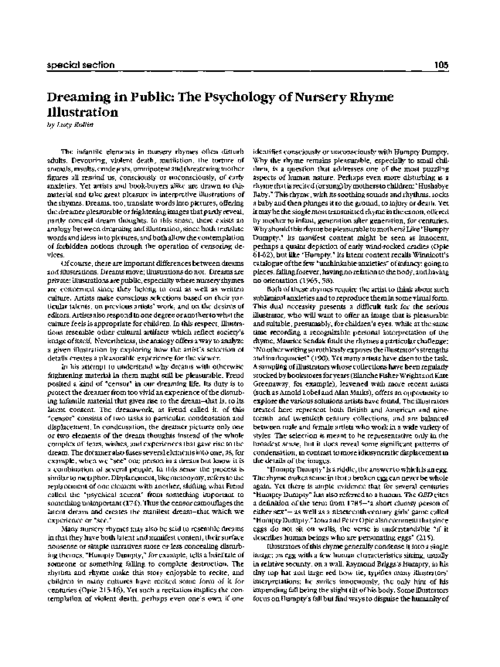托福分数测试HOT
托福课程优惠HOT
托福正价课试听0元
新托福机考练习NEW
0元讲座HOT
新版托福入门课程HOT
托福入门导学NEW
4000人报
托福机经
PDF版
TPO练习
官方授权
资料下载
826套
专业测评
40118人已测
高分经验
1193帖

扫码免费领资料
内含托福全科备考资料
更有免费水平测试及备考规划

扫码关注掌握一手留学资讯
回复XDF免费水平测试
4月15日托福听力中考到关于婴儿对韵律的感知的内容,为了帮助大家熟悉2017年4月15日托福听力考试内容,新东方在线托福网为大家带来托福听力背景知识:婴儿对韵律的感知一文,希望对大家托福备考有所帮助。更多精彩尽请关注2017年4月15日托福考情回顾总结(http://toefl.koolearn.com)!
Dreaming in Public:
The Psychology of Nursery Rhyme Illustration
Lucy Rollin (bio)
The infantile elements in nursery rhymes often disturb adults. Devouring, violent death, mutilation, the torture of animals, insults, crude jests, omnipotent and threatening mother figures all remind us, consciously or unconsciously, of early anxieties. Yet artists and book-buyers alike are drawn to this material and take great pleasure in interpretive illustrations of the rhymes. Dreams, too, translate words into pictures, offering the dreamer pleasurable or frightening images that partly reveal, partly conceal dream thoughts. In this sense, there exists an analogy between dreaming and illustration, since both translate words and ideas into pictures, and both allow the contemplation of forbidden notions through the operation of censoring devices.
Of course, there are important differences between dreams and illustrations. Dreams move; illustrations do not. Dreams are private; illustrations are public, especially where nursery rhymes are concerned since they belong to oral as well as written culture. Artists make conscious selections based on their particular talents, on previous artists' work, and on the desires of editors. Artists also respond in one degree or another to what the culture feels is appropriate for children. In this respect, illustrations resemble other cultural artifacts which reflect society's image of itself. Nevertheless, the analogy offers a way to analyze a given illustration by exploring how the artist's selection of details creates a pleasurable experience for the viewer.
In his attempt to understand why dreams with otherwise frightening material in them might still be pleasurable, Freud posited a kind of "censor" in our dreaming life. Its duty is to protect the dreamer from too vivid an experience of the disturbing infantile material that gives rise to the dream—that is, to its latent content. The dreamwork, as Freud called it, of this "censor" consists of two tasks in particular condensation and displacement. In condensation, the dreamer pictures only one or two elements of the dream thoughts instead of the whole complex of fears, wishes, and experiences that gave rise to the dream. The dreamer also fuses several elements into one, as, for example, when we "see" one person in a dream but know it is a combination of several people. In this sense the process is similar to metaphor. Displacement, like metonymy, refers to the replacement of one element with another, shifting what Freud called the "psychical accent" from something important to something unimportant (174). Thus the censor camouflages the latent dream and creates the manifest dream—that which we experience or "see."
Many nursery rhymes may also be said to resemble dreams in that they have both latent and manifest content, their surface nonsense or simple narratives more or less concealing disturbing themes. "Humpty Dumpty," for example, tells a brief tale of someone or something falling to complete destruction. The rhythm and rhyme make this story enjoyable to recite, and children in many cultures have recited some form of it for centuries (Opie 215-16). Yet such a recitation implies the contemplation of violent death, perhaps even one's own if one identifies consciously or unconsciously with Humpty Dumpty. Why the rhyme remains pleasurable, especially to small children, is a question that addresses one of the most puzzling aspects of human nature. Perhaps even more disturbing is a rhyme that is recited (or sung) by mothers to children: "Hushabye Baby." This rhyme, with its soothing sounds and rhythms, rocks a baby and then plunges it to the ground, to injury or death. Yet it may be the single most transmitted rhyme in the canon, offered by mother to infant, generation after generation, for centuries. Why should this rhyme be pleasurable to mothers? Like "Humpty Dumpty," its manifest content might be seen as innocent, perhaps a quaint depiction of early wind-rocked cradles (Opie 61-62), but like "Humpty," its latent content recalls Winnicott's catalogue of the few "unthinkable anxieties" of infancy: going to pieces, falling forever, having no relation to the body, and having no orientation (1965, 58).
Both of these rhymes require the artist to think about such subliminal anxieties and to reproduce them in some visual form. This dual necessity presents a difficult task for the serious illustrator, who...

以上就是新东方在线托福网为你带来的托福听力背景知识:婴儿对韵律的感知,更多精彩敬请关注新东方在线托福网(http://toefl.koolearn.com)。
本文关键字: 2017年4月15日托福 托福听力背景资料

 资料下载
资料下载
2021-2024托福机经试题|答案|范文下载
发布时间:2024-02-21关注新东方在线托福
回复【XDF】获取
托福全科备考资料大礼包
发布时间:2024-02-21关注新东方在线托福
回复【XDF】获取
托福正价课试听课程包
发布时间:2024-02-21关注新东方在线托福
回复【XDF】获取
托福定制备考规划
发布时间:2024-02-21关注新东方在线托福
回复【XDF】获取
托福TPO免费模考
发布时间:2024-02-21关注新东方在线托福
回复【XDF】获取
托福免费水平测试
发布时间:2024-02-21关注新东方在线托福
回复【XDF】获取
托福写作新题型模拟题+范文汇总[ETS发布]
发布时间:2023-07-30关注新东方在线托福
回复【XDF】获取
2023全年托福机经PDF版下载
发布时间:2023-06-17关注新东方在线托福
回复【XDF】获取
2022全年托福机经PDF版下载
发布时间:2023-06-17关注新东方在线托福
回复【XDF】获取
2022全年写作托福机经整理
发布时间:2023-01-13关注新东方在线托福
回复【XDF】获取
2022年托福考后题目回忆
发布时间:2023-01-13关注新东方在线托福
回复【XDF】获取
托福口语黄金80题附录音
发布时间:2023-01-13关注新东方在线托福
回复【XDF】获取
新东方IBT写作网络课堂录音[.rar]
发布时间:2023-01-13关注新东方在线托福
回复【XDF】获取
21天托福听力提升计划
发布时间:2023-01-13关注新东方在线托福
回复【XDF】获取
不怕跑题偏题,这份写作资料请收好
发布时间:2023-01-13关注新东方在线托福
回复【XDF】获取
托福阅读提分技巧锦囊妙计
发布时间:2023-01-13关注新东方在线托福
回复【XDF】获取
口语拖后腿?因为你缺少这套万能句式资料
发布时间:2019-11-01关注新东方在线托福
回复【XDF】获取
攻破托福听力难关的资料包
发布时间:2023-01-13关注新东方在线托福
回复【XDF】获取
看剧学英语,经典美剧一键获取
发布时间:2019-11-01关注新东方在线托福
回复【XDF】获取
原版外刊资源合集|精心打包整理
发布时间:2019-11-01关注新东方在线托福
回复【XDF】获取

关注新东方在线托福,
回复【XDF】获取大礼包

 推荐阅读
推荐阅读
很多考生对托福听力评分表一知半解,不知道如何根据自己的听力水平和目标分数来制定合理的备考计划和策略。本文将为你揭开托福听力评分表的秘密,告诉你如何提高你的听力分数。
托福听力是托福考试的重要部分,也是很多考生的难点。托福听力的评分标准和评分表是什么?如何根据托福听力评分表提高听力水平?本文将为你详细解答。
新东方在线托福整理了托福听力评分表、托福听力TPO练习网站、听力考试时长和题型等内容,今天带来的是托福听力28题改革后评分标准,帮助大家更好地了解托福听力考试,从而轻松应对托福考试!
新东方在线托福整理了托福听力评分表、托福听力TPO练习网站、听力考试时长和题型等内容,今天带来的是新托福听力28道题评分标准和分数对照表,帮助大家更好地了解托福听力考试,从而轻松应对托福考试!
新东方在线托福整理了托福听力评分表、托福听力TPO练习网站、听力考试时长和题型等内容,今天带来的是2023新版托福评分表28道题及算分标准汇总,帮助大家更好地了解托福听力考试,从而轻松应对托福考试!



 资料下载
资料下载
关注新东方在线托福
回复【XDF】获取
关注新东方在线托福
回复【XDF】获取
关注新东方在线托福
回复【XDF】获取
关注新东方在线托福
回复【XDF】获取
关注新东方在线托福
回复【XDF】获取
关注新东方在线托福
回复【XDF】获取
关注新东方在线托福
回复【XDF】获取
关注新东方在线托福
回复【XDF】获取
关注新东方在线托福
回复【XDF】获取
关注新东方在线托福
回复【XDF】获取
关注新东方在线托福
回复【XDF】获取
关注新东方在线托福
回复【XDF】获取
关注新东方在线托福
回复【XDF】获取
关注新东方在线托福
回复【XDF】获取
关注新东方在线托福
回复【XDF】获取
关注新东方在线托福
回复【XDF】获取
关注新东方在线托福
回复【XDF】获取
关注新东方在线托福
回复【XDF】获取
关注新东方在线托福
回复【XDF】获取
关注新东方在线托福
回复【XDF】获取

 阅读排行榜
阅读排行榜
 相关内容
相关内容